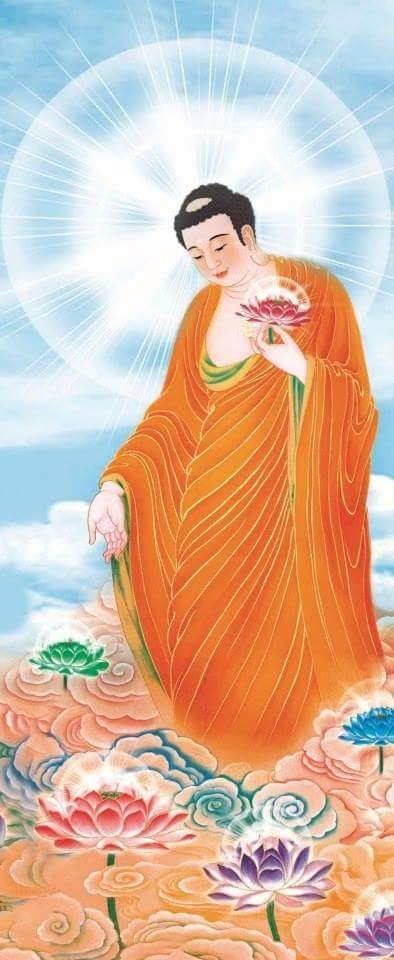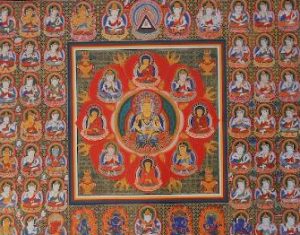Pure Land Buddhism at a glance
Among the many different schools of Chinese Buddhism—such as Chan (Zen in Japanese), Tientai, Huayen, and Fashiang—Pure Land arguably has the largest following. While its doctrinal development took place in China, Pure Land is the major school of Buddhism in Hong Kong, Japan, Taiwan, Vietnam, and other Asian countries.
The main reason for this popularity is that Pure Land Buddhism is characterized by its “easy practice:” the repetition of Amitabha Buddha’s sacred name (Na-Mo-A-Mi-Tuo-Fo) by adherents in their daily lives. While almost all Chinese Buddhists know how to recite Namo Amituofo in a temple, at home, or under any other circumstances, it does not mean that they are necessarily followers of Pure Land Buddhism, yet it does show how deeply Pure Land practice has penetrated the Chinese consciousness.
Na-Mo-A-Mi-Tuo-Fo is the name of the Buddha of infinite light and life, Amitabha. In Pure Land Buddhism, devoted recitation of Amitabha’s name is believed to be the quickest way for monastics and lay people to gain postmortem entry (rebirth) into the blissful realm known as the Pure Land—the home of Amitabha Buddha.
Pure Land adherents joyfully and sincerely entrust themselves to Amitabha’s deliverance, thus “faith by devotion” is the first step necessary for gaining rebirth in Amitabha’s Land of Bliss. All the inhabitants of the Pure Land are Amitabha’s dependents, and are also students, and enjoy almost the same wisdom and power as Amitabha Buddha. They are also assured of attaining enlightenment and Buddhahood. At first glance, this teaching seems similar to the Christian concept of salvation through Jesus Christ.
An independent school, or affiliated with other schools?
A temple of any Buddhist school (such as Chan) that includes Amitabha-recitation in its ritual or daily practice is said to propagate Pure Land Buddhism. Likewise, a layperson or monastic who recites Namo Amituofo for any reason may think that he is practicing Pure Land Buddhism. Is it really that simple? Can Pure Land teachings be practiced in affiliation with other schools of Buddhism?
As Pure Land self-identifies as a school of Buddhism, it follows that it must have its own complete and independent system of teachings. It must also be able to distinguish itself from other systems, both Buddhist and non-Buddhist. For instance, the Land of Bliss is not an ordinary pure land, or a mere heavenly realm, as many people think.
That said, there is also much overlap between Pure Land and other Buddhist schools. In any Mahayana school, bodhisattvas are required to make vows in their causal grounds and set forth their Bodhi Mind to deliver sentient beings of the Ten Directions. They must actively pursue wisdom for long periods of time to realize the ultimate truth. Moreover, they must achieve and accumulate immeasurable merit and virtue through myriad self-powered practices. In this way, they can deliver sentient beings of the Ten Directions before attaining Perfect Enlightenment and achieving Buddhahood.
However, the Pure Land teachings seem to set forth a different narrative. A Pure Land practitioner is a “receiver” of merit, rather than a “donor” of merit, according to the bodhisattva teachings. He is a recipient of infinite merit and virtue, dedicated by Amitabha Buddha to all those who practice the exclusive recitation of his sacred name. This is why Pure Land asserts itself as an independent school. Other schools use Amitabha’s name as a means to generate merit towards rebirth in the Pure Land. The Pure Land school teaches “faith by devotion” and receiving Amitabha’s merit and virtue through the exclusive recitation of his name. In this way, Pure Land adherents are reborn in the Land of Bliss naturally and effortlessly.
The two streams
Obviously, Pure Land stands in sharp contrast to other schools of Mahayana Buddhism, which focus almost entirely on meditation as a means to calm and purify the mind. However, these two Buddhist streams—Pure Land Buddhism and “conventional” Buddhism—are not necessarily antagonistic. Together, they fully elucidate the bodhisattva career, one focusing on the donor of merit, and the other on the receiver of merit.
In the West, Pure Land Buddhism is quietly but diligently practiced in communities of Asian immigrants, most of whom do not speak English. They generally meet in palace-like temples in most large cities of Europe and North America, and often escape the notice of mainstream Western Buddhists, who tend to think of Pure Land as “ethnic” Buddhism restricted to a particular group of Asian people. However, some scholars of religion are increasingly emphasizing that Pure Land is one of two distinct but important Buddhist streams in Western countries.
Considering that both Pure Land Buddhism and Christianity emphasize faith by devotion, there is a great deal of potential for propagating Pure Land in the West. Unfortunately, because of a relative lack of English-language material, Pure Land Buddhism remains unfamiliar to many Westerners and is currently less popular than Theravada, Vajrayana, or Zen Buddhism. When more English information is published and transmitted through social media, Pure Land Buddhism will likely grow in popularity. Westerners are hungry for religion that can be practiced by ordinary people in the midst of ordinary life, and the Pure Land path was taught specifically for this reason.
Moreover, Pure Land Buddhism provides a choice for other Buddhists who practice the meditative virtues. Should they grow discouraged at the prospect of practicing for many years to attain enlightenment, they may consider switching to Pure Land Buddhism. Through Amitabha-recitation, they can put faith faith in Amitabha’s deliverance and attain rebirth in the Land of Bliss, where conditions for practice are so optimal that Enlightenment naturally unfolds.
Back to Tradition and Innovation: Chinese Buddhism Beyond Asia Special Issue 2016
Related feature from Buddhistdoor Global
Teachings of Amitabha Buddha (Alan Kwan’s column on BDG)












